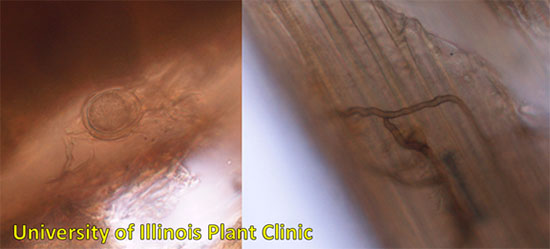Issue 6, June 4, 2018
Rotten Weather and Root Rots
We've received a number of samples with root rot at the Plant Clinic recently. Approximately half have been infected with Pythium, with the other half infected with Rhizoctonia. This is not a huge surprise given the extremely varied weather we've been experiencing.
There are two basic groups of root rots: seedling root rots and damping-off, and root nibblers that usually affect mature plants. Root rots can be caused by both fungi and oomycetes, fungal-like organisms that are also known as water molds. Pythium and Phytophthora are two common genera of oomycetes that cause root rots. Common fungal pathogens include Rhizoctonia and Fusarium species.

Common root rot pathogens. Left: Pythium oospore; Right: Rhizoctonia hyphae. Note the dark brown color of the root tissue; in healthy plants, this tissue would be white.
Seedling root rots often cause the death of the plant, either because the seedling cannot establish or because the rot extends to the crown of the plant and causes a condition known as damping-off. Most people who have grown plants from seed are familiar with damping-off: one day the seedlings look normal, the next day they've collapsed due to a rotten area at the base of the plant. Seedling death due to root rots tends to be fairly fast and dramatic, because the plants have so few roots that they can't compensate for the damage caused by the disease.
Root rots of established plants can also occur. These pathogens are often the same or related to the seedling root pathogens. They often act more as root nibblers in mature plants, damaging the root tips and smaller roots while not causing extensive injury to the overall root system. Healthy plants can often overcome the damage. However, if the plant becomes stressed due to environmental conditions such as drought or due to other pest issues, the plant may have a more difficult time maintaining its vigor.
We think of root rots as being favored by cool, wet weather. This is true for some root rot pathogens (generally, the oomycetes) but warm, dry weather tends to favor the fungal root rots. Once the pathogen has gained entry to the root system, there's not much we can do. Fungicide seed treatments can be used to protect seedling root systems. Ensuring good drainage and adequate water during the growing season is also important for managing these diseases. For greenhouse and nursery producers, using sterile growing media and sanitizing tools and equipment is important to reduce the spread of disease. Unfortunately, many of these pathogens are ubiquitous in our soils, so our best management is keeping our plants healthy and reducing environmental factors that favor the development of root rot diseases. (Diane Plewa)
Author:
Diane Plewa